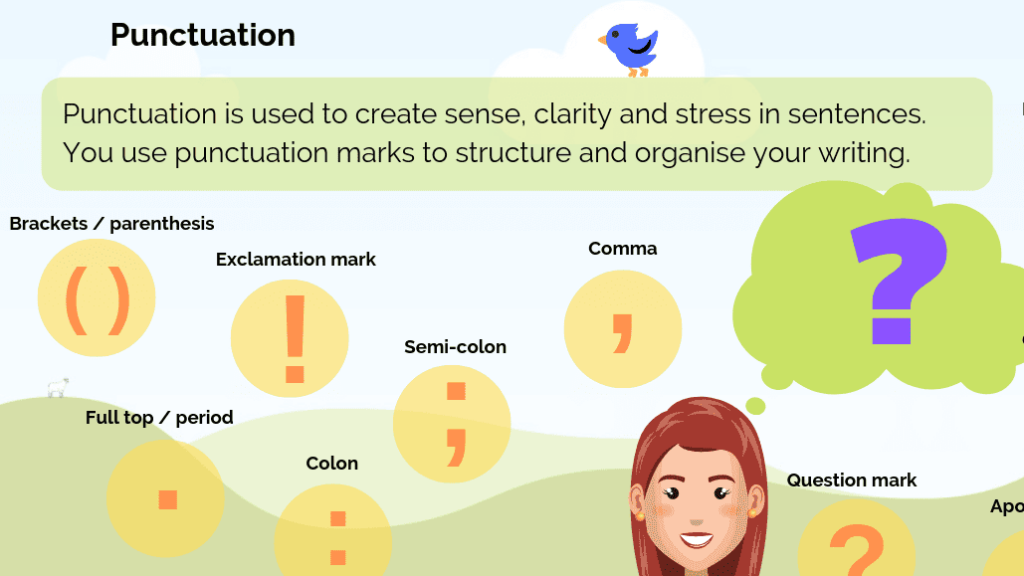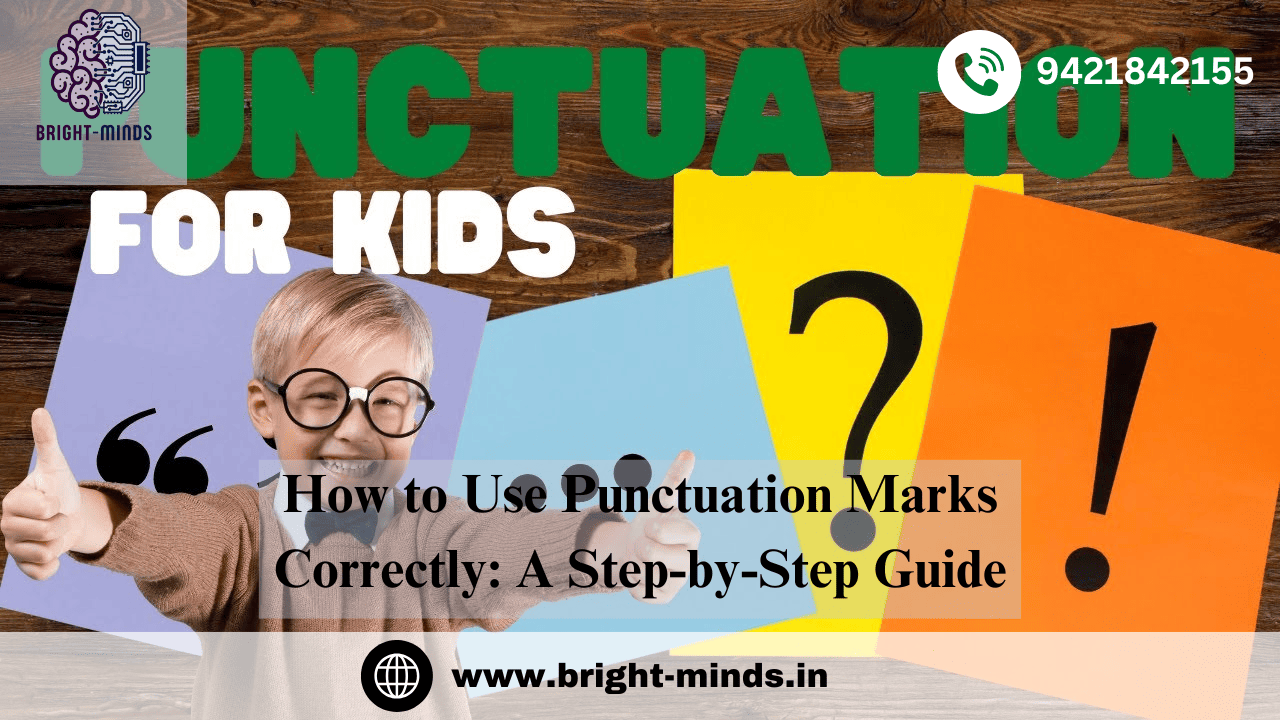Introduction
The unsung heroes of writing, punctuation marks help readers navigate the complex web of sentences, express feelings, and offer clarity. One of the most important steps in helping children become proficient communicators is teaching them how to use punctuation appropriately. We will look at a methodical approach to studying punctuation in this tutorial, which will make learning enjoyable and engaging.
Why Is Punctuation Important?
When writing, punctuation is really important. It :
- Adds Clarity: Clarity is added by separating concepts and simplifying language.
- Communicates Tone: Shows hesitations, enthusiasm, or inquiries.
- Prevents Miscommunication: Prevents meaning ambiguity and uncertainty.
For instance:
Grandma, let’s eat!
Grandma, let’s eat!
Basic Punctuation Marks and Their Functions
Here is a brief summary of the punctuation symbols that kids should learn:
- Period (.): Ends a sentence.
Example: I love to read. - Question Mark (?): Ends a question.
Example: What is your name? - Exclamation Mark (!): Shows strong emotions or excitement.
Example: Hooray! We won! - Comma (,): Separates items in a list, clauses, or pauses.
Example: I like apples, bananas, and grapes. - Quotation Marks (“ ”): Encloses spoken or quoted words.
Example: She said, “I love books.” - Apostrophe (’): Shows possession or contractions.
Example: It’s my dog’s toy. - Colon (:): Introduces a list or explanation.
Example: Bring these items: a notebook, a pen, and a ruler. - Semicolon (;): Connects related independent clauses.
Example: I went to the park; it was a sunny day. - Parentheses ( ): Adds extra information.
Example: My cat (a fluffy tabby) loves to nap. - Hyphen (-): Joins words or parts of words.
Example: A well-known author.
Step-by-Step Guide to Teaching Punctuation

Step 1: Start Simple
Introduce the period, question mark, and exclamation mark, among other basic punctuation marks. To illustrate how to use them, use brief sentences.
- Activity Idea: Write phrases without punctuation and invite kids to add the appropriate symbols.
Example : I adore ice cream (Response: I adore ice cream.)
Are you a dog lover? (Response: Do you enjoy dogs?)
Whoa, this is incredible. (Reaction: Whoa! This is incredible!)- I love ice cream (Answer: I love ice cream.)
- Do you like dogs (Answer: Do you like dogs?)
- Wow this is amazing (Answer: Wow! This is amazing!)
Step 2: Master Commas
Divide commas into manageable lessons because they can be challenging:
- dividing up a list of elements.
- following initial phrases with commas (e.g., Yes, I agree.
- Commas are added to complicated sentences.
- Idea for an Activity: Make a “comma detective” game in which children have to locate missing commas in sentences.
Step 3: Introduce Quotation Marks
Describe how quote marks indicate what is being said. Make use of storybook examples.
- Activity Idea:Act out a dialogue. A statement is spoken by one child and then written with quotation marks by another.
- Example:
First child: I adore pizza.
Child 2: “I love pizza,” he added.
Step 4: Teach Apostrophes
Teach the two main uses of apostrophes:
- Ownership (Sara’s book, for instance)
- contractions (don’t, it’s, etc.).
- Activity Idea: Get kids to match phrases with and without contractions in a matching game.
- For instance:
- Avoid → It is → It’s
Step 5: Explore Colons and Semicolons
Give basic instances to introduce these sophisticated punctuation marks:
- Lists are introduced by colons (e.g., I need pencils, erasers, and rulers).
- Two related sentences are joined by semicolons (e.g., I went to bed early; I was fatigued).
- Activity Idea: Show children two sentences on flashcards and ask them to join them with a semicolon.
Step 6: Use Fun Visuals and Tools
Make Use of Fun Images and Resources
Visual aids and interactive resources help kids learn more effectively:
- Make posters that demonstrate punctuation.
- Practice your punctuation with applications and games on the internet.
Fun Activities to Reinforce Learning
1. Punctuation Relay
On cards, write sentences without punctuation. Teams of children should be formed, and they should compete to add the proper punctuation.
2. Punctuation Treasure Hunt
Throughout the room, conceal punctuation marks. Give children sentences with missing punctuation, and ask them to locate and insert the appropriate ones.
3. Storytime with Errors
Read aloud a story that has purposeful punctuation mistakes. Have children identify and fix them..
4. Emoji Punctuation Match
Use emojis to represent punctuation marks:
- 🙂 = Period
- ❓ = Question Mark
- 😮 = Exclamation Mark
Common Challenges and Solutions
- Confusion Between Similar Marks
- Children may forget the rules for quotation marks or confuse commas with periods.
- Solution: Use games and repeated practice to reinforce.
- Overusing Exclamation Marks
- Children’s writing may have an excessive number of exclamation points.
- Solution: Provide instances of excessive use to illustrate moderation.
- Misplaced Apostrophes
- Pluralization versus possession might be perplexing.
- Solution: Explain using visual aids like diagrams or charts.
Creating a Punctuation-Rich Environment
Use punctuation posters to adorn your study space or classroom.
Make punctuation practice-focused books and worksheets available.
Encourage children to write in their journals every day, editing their punctuation as they go.
Benefits of Mastering Punctuation Early
- Improved Communication: Kids get better at efficiently and concisely expressing themselves.
- Better Reading Comprehension: Text comprehension is improved by appropriate punctuation.
- Confidence in Writing: When children write with proper punctuation, they feel more competent and self-assured.
Conclusion
- Children should be taught how to properly utilize punctuation since it will help them in their future. You may make punctuation classes enjoyable and effective by dissecting each punctuation mark, employing interesting exercises, and offering regular practice.
- Encourage children to write with a variety of punctuation styles to make learning fun and creative! It will be easy to learn punctuation with these step-by-step techniques.
Also Read:
https://bright-minds.in/unlocking-word-meaning-for-class-ukg-english-to-hindi/

